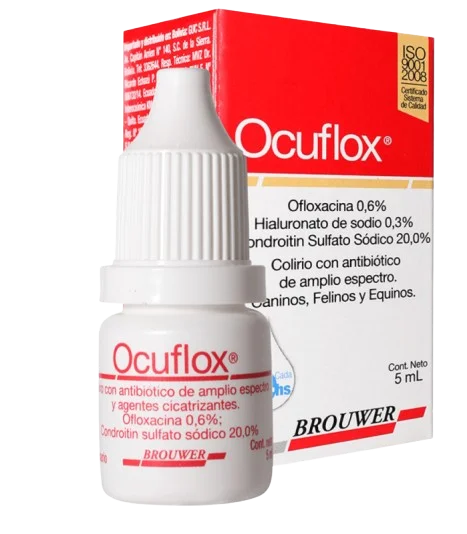It is safe for Corneal Ulcers & Severe Infections. Unlike some antibiotics, Ocuflox penetrates deep into eye tissues, making it useful for corneal ulcers and serious bacterial infections. It has less bacterial resistance than older antibiotics, like erythromycin or sulfa-based drops. It is Non-Irritating & Comfortable for most users. Users find it well-tolerated with minimal stinging. It is FDA-Approved & Clinically Proven, backed by research, it is safe and effective in treating bacterial eye infections. It is a safe option for pediatric bacterial eye infections. People with bacterial conjunctivitis (pink eye), patients with corneal ulcers or keratitis, post-eye surgery patients (prescribed to prevent infections), and individuals with bacterial eye infections resistant to other antibiotics can use it. Ocuflox is NOT effective for viral or fungal eye infections.
What is Ocuflox?
Ocuflox (Ofloxacin 0.3%) is a fluoroquinolone antibiotic that treats bacterial eye infections by targeting the DNA of the bacteria, stopping its ability to grow and spread.
Mechanism of Action
Inhibits Bacterial DNA Replication
Ocuflox blocks two key bacterial enzymes: DNA gyrase and topoisomerase IV.
These enzymes are essential for bacterial DNA replication, repair, and survival.
Prevents Bacterial Growth & Kills the Infection
By stopping DNA replication, Ocuflox prevents bacteria from multiplying.
The bacteria die off, and the infection clears up.
Fast Penetration & Deep Action
Ocuflox quickly penetrates the cornea and eye tissues, making it useful for mild and severe bacterial infections, including corneal ulcers.
How Long Does It Take to Work?
- Symptoms improve within 24–48 hours.
- Full recovery usually takes 5–7 days, depending on the severity of the infection.
Always complete the course of treatment, even if symptoms improve early, to prevent antibiotic resistance.
What are the Uses and Benefits of Ocuflox?
Uses of Ocuflox Eye Drops
Bacterial Conjunctivitis (Pink Eye)
Effectively treats bacterial pink eye, reducing redness, swelling, discharge, and irritation.
Corneal Ulcers
Penetrates deep into the cornea to treat severe bacterial ulcers that could lead to vision loss if left untreated.
Keratitis (Corneal Inflammation because of bacteria)
Ocuflox Eye Drops helps eliminate bacterial infections in the cornea, preventing long-term damage.
Blepharitis (Eyelid Inflammation because of bacteria)
Ocuflox Eye Drops reduces eyelid redness, swelling, and crusting caused by bacterial infections.
Post-Eye Surgery Infection Prevention (Off-Label Use)
Doctors sometimes prescribe it after cataract surgery, LASIK, or other eye procedures for further infection prevention.
Benefits of Ocuflox Eye Drops
- Fast-Acting Relief–Symptoms improve within 24–48 hours.
- Broad-Spectrum Antibiotic–Treats bacterial infections, including resistant strains.
- Deep Corneal Penetration–Unlike some antibiotics, Ocuflox reaches deep into eye tissues, making it useful for severe infections.
- Safe & Well-Tolerated–Minimal side effects and low risk of irritation.
- Lower Risk of Antibiotic Resistance–The effect is better than older antibiotics, like erythromycin or sulfa-based eye drops.
- FDA-Approved & Clinically Tested–Proven, safe, and effective for treating bacterial eye infections.
- Suitable for Adults & Children (above one year old).
What are the Safe Dosages of Ocuflox?
Standard Dosage for Common Conditions
Bacterial Conjunctivitis (Pink Eye)
Days 1 & 2: 1–2 drops every 2–4 hours in the affected eye(s) during waking hours.
Days 3 to 7: 1–2 drops four times daily until the infection clears.
Total Treatment Duration: 5–7 days.
Corneal Ulcers (More Severe Infections)
Days 1 & 2: 1–2 drops every 30 minutes while awake. At night, 1–2 drops every 4–6 hours.
Days 3 to 7: 1–2 drops every hour while awake.
After Day 7 (if needed, as prescribed by a doctor): 1–2 drops four times daily until healing is complete.
Total Treatment Duration: Varies depending on the severity of the ulcer but often 2–3 weeks or longer under doctor supervision.
Important Usage Instructions
- Use the entire prescribed course–Stopping without consulting your doctor can cause the infection to return.
- Shake well before use if using a suspension.
- Wait 5 minutes before applying other eye medications.
- Avoid wearing contact lenses during treatment unless your doctor allows it.
- Do not touch the dropper tip to your eye to prevent contamination.
Warning
If symptoms worsen or do not improve within a few days, consult your doctor. Do not exceed the prescribed dose, as overuse can lead to resistance or irritation.
How to take Ocuflox?
Step-by-Step Guide to Applying Ocuflox Eye Drops
Wash Your Hands
Use soap and water to clean your hands before touching your eyes or the eye drop bottle.
Shake the Bottle (If Using Suspension)
Gently shake the bottle to mix the medication properly.
Tilt Your Head Back & Pull Down the Lower Eyelid
Use one hand to tilt your head back. With the other hand, gently pull down your lower eyelid, creating a small pocket.
Hold the Dropper Above the Eye
Position the bottle close to your eye, but do not touch it to prevent contamination.
Instill the Drops
Squeeze 1–2 drops into the lower eyelid pocket as prescribed.
Close Your Eyes & Apply Light Pressure
Close your eyes gently for 1–2 minutes and apply light pressure on the inner corner of the eye (near the nose) to prevent drainage into the throat.
Wipe Excess & Avoid Blinking Too Much
Use a clean tissue to wipe off any extra liquid. Do not rub your eyes.
Wait Before Using Other Eye Medications
If using multiple eye medications, wait at least 5 minutes between each to allow proper absorption.
Additional Tips for Safe Use
- Use it only as prescribed. Do not skip doses or stop early.
- Avoid touching the dropper tip to your eye, hands, or surface.
- Do not wear contact lenses during treatment unless advised by your doctor.
- Store at room temperature. Keep the bottle tightly closed when not in use.
Missed Dose
If you miss a dose, apply it as soon as possible. If it is close to your next dose, skip the missed dose—do not double up to catch up.
When Should I Avoid Ocuflox or Use Ocuflox Cautiously?
When to AVOID Ocuflox (Do NOT Use If You Have These Conditions)
Viral or Fungal Eye Infections
Ocuflox Eye Drops is ONLY effective against bacterial infections. It does NOT work for viral conjunctivitis (pink eye), herpes simplex, or fungal eye infections.
Allergy to Ofloxacin or Fluoroquinolones
If you have had an allergic reaction to Ofloxacin, Ciprofloxacin, Levofloxacin, Moxifloxacin, or other fluoroquinolone antibiotics, avoid using Ocuflox. Symptoms of an allergy include severe itching, swelling, rash, breathing difficulty, or eye irritation.
Tendon Disorders Related to Fluoroquinolones
If you have experienced tendonitis or tendon rupture because of fluoroquinolone antibiotics, avoid Ocuflox, as these drugs can weaken tendons.
Children Under 1-Year-Old
Doctors do not recommend Ocuflox for infants under 1 year of age.
Pregnant or Breastfeeding Women (Use Only If Necessary)
While Ocuflox Eye Drops is low risk, a doctor should use it during pregnancy or breastfeeding only if necessary and prescribe it.
When to Use Ocuflox Cautiously (Only Under Medical Supervision)
Severe Dry Eye or Corneal Disorders
Ocuflox can cause mild irritation. Use caution if you have chronic dry eye, corneal thinning, or a history of transplants.
Prolonged Use (More than 10 Days)
Long-term use of Ocuflox can lead to
- Bacterial Resistance–Overuse may make bacteria resistant, reducing effectiveness.
- Secondary Fungal Infections–Prolonged antibiotic use can promote fungal overgrowth in the eye.
Contact Lens Wearers
Avoid wearing contacts during treatment unless your doctor approves. Bacteria can stick to lenses, worsening infections.
Recent Eye Surgery or Injury
Doctors may prescribe Ocuflox post-surgery, but only under medical supervision. One should not use it on open wounds without approval.
What are the Side effects of Ocuflox?
Ocuflox Eye Drops is well-tolerated, but like all medications, it may cause mild-to-moderate side effects in some users. Most side effects are temporary and improve as your eyes adjust to the medication.
Common Ocuflox Side Effects
- Mild Eye Irritation or Burning Sensation
- Blurred Vision
- Eye Dryness or Watery Eyes
- Light Sensitivity (Photophobia)
- Mild Eye Redness
These mild side effects are usually not serious and go away.
Severe Ocuflox Side Effects
- Severe Allergic Reactions (Anaphylaxis or Hypersensitivity)
- Persistent or Worsening Eye Redness, Pain, or Swelling
- Severe Eye Irritation or Corneal Damage
- Severe Blurred Vision or Vision Loss
- Secondary Infections (Fungal or Superinfections)
- Tendon Rupture or Muscle Weakness (Rare, but Possible for Fluoroquinolones)





